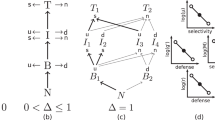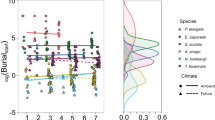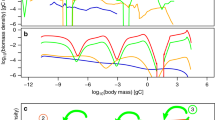Abstract
The relationship between species diversity and ecosystem functioning is a central topic in ecology today1,2. Classical approaches to studying ecosystem responses to nutrient enrichment have considered linear food chains3,4. To what extent ecosystem structure, that is, the network of species interactions, affects such responses is currently unknown. This severely limits our ability to predict which species or functional groups will benefit or suffer from nutrient enrichment and to understand the underlying mechanisms5,6,7,8. Here our approach takes ecosystem complexity into account6,9,10 by considering functional diversity at each trophic level11,12,13,14. We conducted a mesocosm experiment to test the effects of nutrient enrichment in a lake ecosystem. We developed a model of intermediate complexity, which separates trophic levels into functional groups according to size and diet. This model successfully predicted the experimental results, whereas linear food-chain models did not. Our model shows the importance of functional diversity and indirect interactions in the response of ecosystems to perturbations, and indicates that new approaches are needed for the management of freshwater ecosystems subject to eutrophication.
This is a preview of subscription content, access via your institution
Access options
Subscribe to this journal
Receive 51 print issues and online access
$199.00 per year
only $3.90 per issue
Buy this article
- Purchase on Springer Link
- Instant access to full article PDF
Prices may be subject to local taxes which are calculated during checkout

Similar content being viewed by others
References
Johnson, K. H., Vogt, K. A., Clark, H. J., Schmitz, O. J. & Vogt, D. J. Biodiversity and the productivity and stability of ecosystems. Trends Ecol. Evol. 11, 372–377 (1996).
Chapin III, F. S. et al. Biotic control over the functioning of ecosystems. Science 277, 500–504 ( 1997).
Oksanen, L., Fretwell, S. D., Arruda, J. & Niemela, P. Exploitation ecosystems in gradients of primary productivity. Am. Nat. 118, 240–261 ( 1981).
Arditi, R. & Ginzburg, L. R. Coupling in predator-prey dynamics: Ratio-dependence. J. Theor. Biol. 139, 311 –326 (1989).
Hunter, M. D. & Price, P. W. Playing chutes and ladders: heterogeneity and the relative roles of bottom-up and top-down forces in natural communities. Ecology 73, 724–732 (1992).
Polis, G. A. Food webs, trophic cascades and community structure. Aust. J. Ecol. 19, 121–136 ( 1994).
Persson, L., Bengtsson, J., Menge, B. A. & Power, M. E. in Food Webs. Integration of Patterns and Dynamics (eds Polis, G. A. & Winemiller, K. O.) 396–434 (Chapman & Hall, New York, 1996).
Kaunzinger, C. M. K. & Morin, P. J. Productivity controls food-chain properties in microbial communities. Nature 395, 495–497 ( 1998).
McCann, K., Hastings, A. & Huxel, G. R. Weak trophic interactions and the balance of nature. Nature 395, 794–798 (1998).
Polis, G. A. Stability is woven by complex webs. Nature 395, 744–745 (1998).
Leibold, M. A. Resource edibility and the effects of predators and productivity on the outcome of trophic interactions. Am. Nat. 134, 922 –949 (1989).
Spiller, D. A. & Schoener, T. W. A terrestrial field experiment showing the impact of eliminating top predators on foliage damage. Nature 347, 469– 472 (1990).
Leibold, M. A. & Wilbur, H. M. Interactions between food-web structure and nutrients on pond organisms. Nature 360, 341–343 ( 1992).
Abrams, P. A. Effect of increased productivity on the abundances of trophic levels. Am. Nat. 141, 351–371 ( 1993).
Gleeson, S. K. Density dependence is better than ratio dependence. Ecology 75, 1834–1835 (1994).
Mittelbach, G. G., Osenberg, C. W. & Leibold, M. A. in Size-structured Populations. Ecology and evolution (eds Ebenman, B. & Persson, L.) 217–235 (Springer, Berlin, 1988).
Pimm, S. L., Lawton, J. H. & Cohen, J. E. Food web patterns and their consequences. Nature 350, 669–674 ( 1991).
Levins, R. The qualitative analysis of partially specified systems. Ann. NY Acad. Sci. 231, 123-138 (1974 ).
Bender, E. A., Case, T. J. & Gilpin, M. E. Perturbation experiments in community ecology: theory and practice. Ecology 65, 1– 13 (1984).
Leibold, M. A., Chase, J. M., Shurin, J. B. & Downing, A. L. Species turnover and the regulation of trophic structure. Annu. Rev. Ecol. Syst. 28, 467–94 (1997).
Menge, B. A. Dectection of direct versus indirect effects: were experiments long enough? Am. Nat. 149, 801–823 (1997).
Gulati, R. D., Lammens, E. H. R. R., Meijer, M. -L. & van Donk, E. Biomanipulation— Tool for Water Management. (Kluwer, Dordrecht, 1990).
Yodzis, P. in Food Webs. Integration of Patterns & Dynamics (eds Polis, G. A. & Winemiller, K. O.) 192–200 (Chapman & Hall, New York, 1996).
Menge, B. A. Indirect effects in marine rocky intertidal interaction webs: patterns and importance. Eco.l Monogr. 65, 21– 74 (1995).
Power, M. E. Top-down and bottom-up forces in food webs: do plants have primacy? Ecology 73, 733–746 ( 1992).
Lacroix, G. & Lescher-Moutoué, F. Interaction effects of nutrient loading and density of young-of-the-year cyprinids on eutrophication in a shallow lake: an experimental mesocosm study. Mem. Ist. Ital. Idrobiol. 48, 53–74 ( 1991).
DeMelo, R., France, R. & McQueen, D. J. Biomanipulation: hit or myth? Limnol. Oceanogr. 29, 941–948 ( 1992).
Lacroix, G., Lescher-Moutoué, F. & Pourriot, R. in Aspects of the Genesis and Maintenance of Biological Diversity (eds Hochberg, M. E., Clobert, J. & Barbault, R.) 162–179 (Oxford Univ. Press, New York, 1996).
Hamlaoui, S., Couté, A., Lacroix, G. & Lescher-Moutoué, F. Nutrient and fish effects on the morphology of the Dinoflagellate. C. R. Acad. Sci. Paris Sci. Vie 321, 39– 45 (1998).
Reynolds, C. S. Vegetation Processes in the Pelagic: A Model for Ecosystem Theory. (Ecology Institute, Oldendorf/Luhe, 1997).
Acknowledgements
We thank A. Bertolo, C. de Mazancourt, A. Gonzalez, M. Hochberg, N. Mouquet, O. Petchey, S. Ponsard, M. van Baalen and S. Yachi for comments on the manuscript. This work was supported by grants from the ‘Programme Environnement, Vies et Sociétés’.
Author information
Authors and Affiliations
Corresponding author
Rights and permissions
About this article
Cite this article
Hulot, F., Lacroix, G., Lescher-Moutoué, F. et al. Functional diversity governs ecosystem response to nutrient enrichment . Nature 405, 340–344 (2000). https://doi.org/10.1038/35012591
Received:
Accepted:
Issue Date:
DOI: https://doi.org/10.1038/35012591
This article is cited by
-
From green to grey: Unravelling the role of urbanization on diversity of dung beetles in an Amazonian landscape
Urban Ecosystems (2023)
-
Unravelling chironomid biodiversity response to climate change in subarctic lakes across temporal and spatial scales
Hydrobiologia (2022)
-
Effects of alder- and salmon-derived nutrients on aquatic bacterial community structure and microbial community metabolism in subarctic lakes
Oecologia (2022)
-
Validation and Assessment of Diffusive Gradients in Thin-Films (DGT) Technique for Measuring Nutrients in Taihu Lake Water with Algae Bloom
Bulletin of Environmental Contamination and Toxicology (2022)
-
Local and landscape features constrain the trait and taxonomic diversity of urban bees
Landscape Ecology (2022)
Comments
By submitting a comment you agree to abide by our Terms and Community Guidelines. If you find something abusive or that does not comply with our terms or guidelines please flag it as inappropriate.



